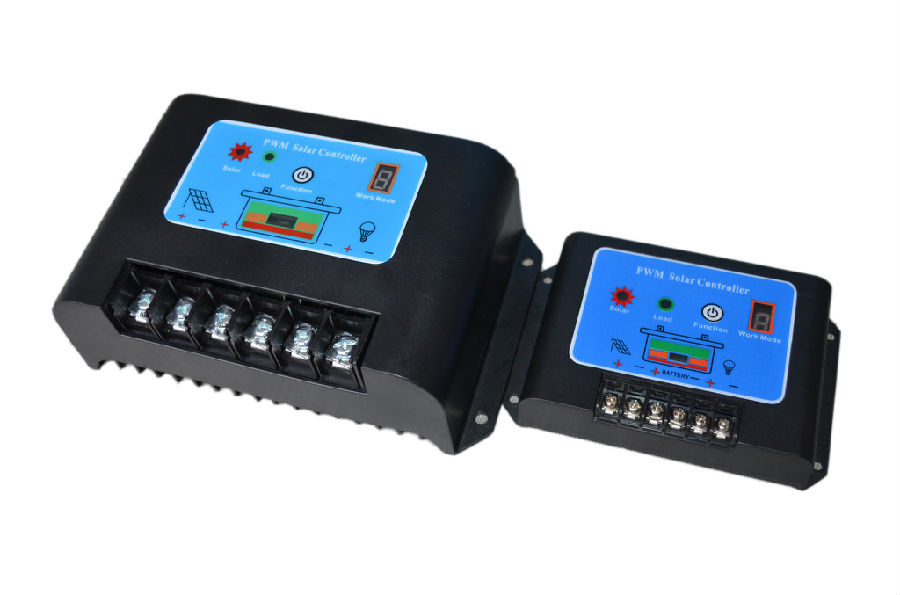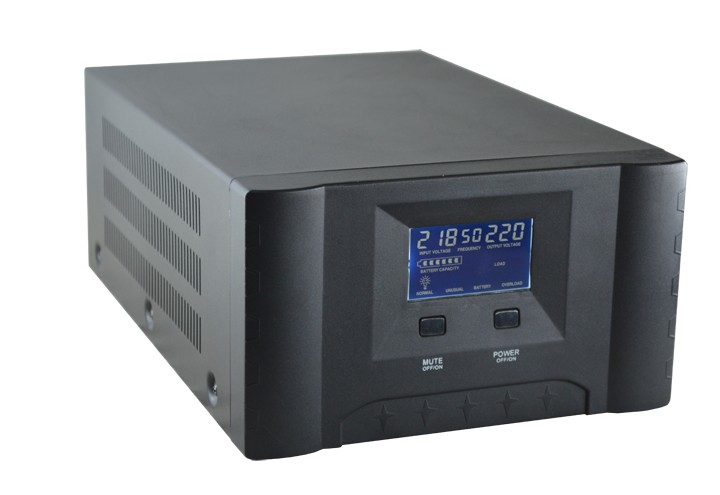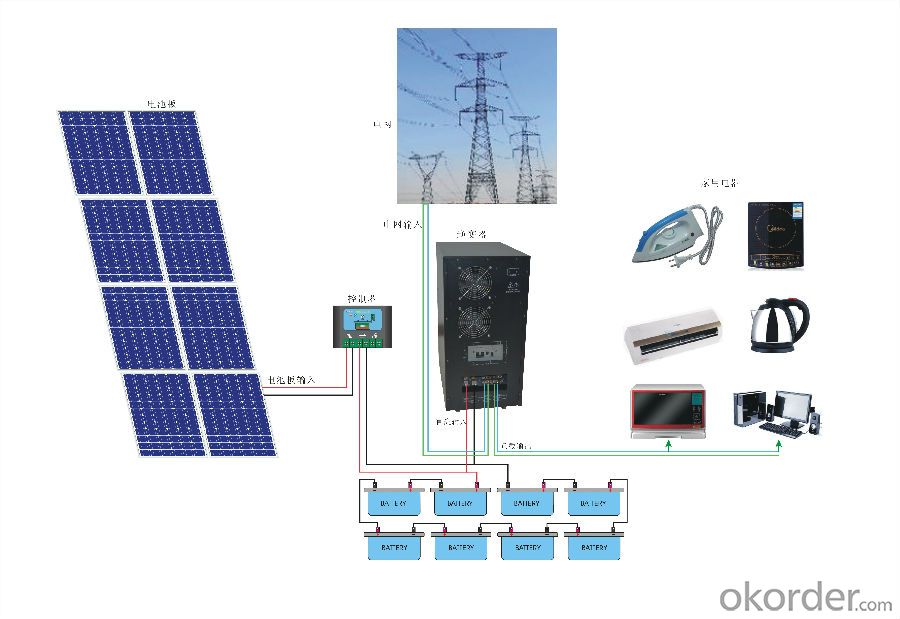Complete 24V 1000W solar panel systems
- Loading Port:
- Guangzhou
- Payment Terms:
- TT OR LC
- Min Order Qty:
- -
- Supply Capability:
- 1000sets set/month
OKorder Service Pledge
OKorder Financial Service
You Might Also Like
Hot sale solar panel system for home use 1000W
Features
Solar cell modules
It converts solar energy into electrical energy and the frames support solar panels.
Charge controller
It supplies direct current regulated from solar modules to the battery or inverter.
Stand-Alone Inverter
It supplies alternative current to loads after rectifying the direct current.
Battery
It supplies the electric power to loads through inverter in case the electric power generated from solar modules is in short supply or at night.
Complete 24V/1000W stand alone solar systems
5×200w poly solar panels//1×24V/50A solar charge controller//1×48V/3000W pure sine wave
inverter//4×12V/200Ah lead acid batteries//ground mounting brackets//50m PV cables for solar
panels connection//dual connectors for solar panels connection//connection cables for batteries.
average produce 6kwh power each day!!!
| 12V/200W Poly-crystalline Solar Panels | ||||||||
| Model: 200P Maximum power:200W Maximum power voltage:35V Maximum power current:5.71A Open circuit voltage:42.48V Short circuit current:6.29A Dimension:1350mm×1000mm×45mm Weight: 17.5kg Solar cells:48pieces(6×8)poly solar cells156mm×156mm;Grade A; CE certification Maximum systems voltage: 1000V |  | |||||||
Wiring of solar panels: 1 panels in series, 5 strings in parallel | ||||||||
| 24V/50A solar charge controller | ||||||||
| Model:KF2450 Rated voltage: 24V Rated current: 50A Over-voltage protection 34V Over-discharge recover voltage: 25V working temperature: -20℃~45℃ Dimension: 184mm×110mm×57mm Weight: 0.66kg Features: battery switch |  | |||||||
| Wiring of solar charge controller: firstly connect solar charge controller with battery bank, then connect solar charge controller with solar panels array, at last connect solar charge controller with loads or pure sine wave inverter | ||||||||
| 48V/3000W Pure Sine Wave Inverter | ||||||||
| Model:XD-NB10224 Rated input voltage:DC24V Input voltage range:75V~125V OR 145V~275V Output voltage:AC210V~AC240V Rated output power:1000W Maximum output power:2000W Output wave form: pure sine wave Dimension:396mm×190mm×240mm Weight:14kg. Working temperature: 0℃~40℃. Battery low voltage shutdown: DC21V |  | |||||||
| 12V/200Ah deep cycle battery | ||||||||
| Deep cycle batteries in our stand alone solar systems have 2000 time charging-discharging cycle at 50% DOD. Gel batteries have better performance than lead acid batteries under cold temperature. besides, these battery are free-maintenance. |
| Package&shipment terms | |||||||||
| 1,We would pack all components into one plywood case and put much foam inside of plywood case, this packing way can make all components stand long distance transportation. 2,Because batteries are a kind of very heavy components and can't be allowed to transport by air, we have to choose sea transportation. though sea transportation would take more days to arrive, however you can save much postage. 3.We would ship the system to any bigger port near to customers, customers need to go to the port and pick up the system. |
More pictures about the solar panel system:

- Q:Are there any risks of electrical shock with solar energy systems?
- Yes, there are potential risks of electrical shock associated with solar energy systems. While solar energy systems are generally considered safe, the presence of high voltages and electrical currents within these systems can pose a risk if not properly managed or handled. Some of the key risks include: 1. Installation and maintenance: During the installation and maintenance of solar panels, there is a risk of coming into contact with live electrical components. This can occur if proper safety procedures are not followed, or if individuals without proper training attempt to handle electrical connections. 2. Faulty equipment or wiring: Malfunctioning or faulty equipment, such as inverters or wiring, can increase the risk of electrical shock. Poor installation practices or inadequate maintenance can also lead to electrical faults, which may expose individuals to dangerous electrical currents. 3. Fire hazards: Although not directly related to electrical shock, faulty electrical components or wiring can increase the risk of fire in solar energy systems. Fires can further exacerbate the risk of electrical shock if individuals attempt to extinguish them without shutting down the electrical system first. To mitigate these risks, it is crucial to follow proper installation and maintenance procedures, which often include working with a licensed professional. Additionally, individuals working with solar energy systems should be trained on proper safety protocols, such as wearing appropriate personal protective equipment and ensuring electrical systems are properly grounded. It is also important to regularly inspect and maintain solar energy systems to identify and address any potential electrical hazards.
- Q:How do solar energy systems contribute to reducing greenhouse gas emissions?
- Solar energy systems contribute to reducing greenhouse gas emissions by harnessing the power of the sun to generate electricity without burning fossil fuels. This clean and renewable energy source helps to replace traditional methods of electricity generation, such as coal-fired power plants, which emit vast amounts of greenhouse gases like carbon dioxide into the atmosphere. By utilizing solar energy, we can reduce our dependency on fossil fuels and mitigate climate change by minimizing the release of harmful greenhouse gases.
- Q:Can a solar energy system be installed in areas with high humidity?
- Yes, a solar energy system can be installed in areas with high humidity. High humidity may impact the performance of the solar panels to some extent, but modern solar panels are designed to withstand various weather conditions, including high humidity. Proper installation and regular maintenance can ensure the efficiency and durability of the system in such areas.
- Q:Can solar energy systems be used in powering concert halls or auditoriums?
- Certainly, concert halls and auditoriums can make use of solar energy systems to generate power. The popularity of utilizing solar energy in large venues like these has been increasing due to its various advantages. The installation of solar panels on the roof or surrounding areas of the venue allows for the capture of sunlight and its conversion into electricity. This renewable energy source can then be used to power all the electrical equipment and lighting systems within the concert hall or auditorium. One of the main benefits of incorporating solar energy systems in these venues is the potential for cost savings. Concert halls and auditoriums typically consume substantial amounts of electricity, especially during events and performances. By harnessing solar power, these venues can significantly reduce their dependence on the traditional power grid and consequently lower their energy bills. Furthermore, solar energy systems require minimal maintenance once they are installed, which further contributes to their long-term cost-effectiveness. Furthermore, the integration of solar energy into concert halls and auditoriums aligns with the global emphasis on sustainability and the reduction of carbon footprints. By utilizing renewable energy sources such as solar power, these venues can considerably decrease their greenhouse gas emissions and promote a more environmentally friendly approach to energy consumption. This not only benefits the venue itself but also contributes to the overall sustainability goals of the local community and society as a whole. However, it is important to take into account that the size and power requirements of concert halls and auditoriums may necessitate a significant investment in solar panels and related equipment. Factors such as the venue's energy demand, available installation space, and the local climate all need to be assessed during the planning stage. Ensuring that the solar energy system is appropriately sized to meet the energy needs of the venue and designed to withstand the specific weather conditions of the location is crucial. In conclusion, it is indeed possible to use solar energy systems to power concert halls or auditoriums. The advantages of employing solar power in these venues encompass cost savings, environmental sustainability, and a reduction in reliance on the traditional power grid. With careful planning and installation, solar energy can provide a reliable and efficient source of electricity to meet the energy demands of such large-scale venues.
- Q:Are there any risks of electrical hazards during installation or maintenance of solar energy systems?
- Yes, there are inherent risks of electrical hazards during the installation or maintenance of solar energy systems. These hazards can arise from working with high-voltage DC electricity, improper grounding, accidental contact with live wires, or faulty equipment. It is crucial to follow safety protocols, receive proper training, use personal protective equipment, and engage qualified professionals to minimize these risks and ensure a safe working environment.
- Q:How does the efficiency of solar panels vary across different panel sizes?
- The efficiency of solar panels generally does not vary significantly across different panel sizes. The efficiency of a solar panel is primarily determined by the quality of the materials used and the technology employed in its manufacturing, rather than its physical size. However, it is worth noting that larger panels typically have a higher wattage output, which means they can generate more electricity per unit of area.
- Q:Can solar energy systems be used for powering wastewater or sewage treatment plants?
- Yes, solar energy systems can be used for powering wastewater or sewage treatment plants. Solar panels can convert sunlight into electricity, which can be used to power various operations within the treatment plants such as pumps, aeration systems, and other equipment. This renewable energy source helps reduce reliance on traditional power sources and lowers the overall carbon footprint of these facilities.
- Q:Are there any risks of electrical shock with solar energy systems?
- Yes, there are potential risks of electrical shock associated with solar energy systems. While solar panels themselves do not produce dangerous voltages, the electrical wiring and components used in the system can carry high voltages that may pose a risk if not handled correctly. It is crucial to have trained professionals install and maintain solar systems to ensure proper grounding, insulation, and safety precautions are in place, reducing the risk of electrical shock to a minimum.
- Q:What are the different financing models for installing solar energy systems?
- There are several financing models available for installing solar energy systems. These include purchasing the system outright with cash, utilizing solar loans or leases, entering into a power purchase agreement (PPA), or participating in community solar programs. Each model has its own advantages and considerations, allowing individuals and businesses to choose the option that best suits their financial situation and goals.
- Q:How does the installation of solar panels affect the building's aesthetics?
- The installation of solar panels can have a significant impact on the aesthetics of a building. Initially, the presence of solar panels on a rooftop or facade may alter the traditional appearance of the structure, which could be a concern for those who prioritize preserving the building's original design. However, modern advancements in solar panel technology have led to more aesthetically pleasing options that blend seamlessly with the building's architecture. Architects and designers are now working to integrate solar panels into the overall design of the building, making them less obtrusive. For instance, solar panels can be incorporated into the design of the roof, creating a sleek and uniform look. In some cases, solar panels can even enhance the visual appeal of a building, adding a contemporary and eco-friendly element to its appearance. Moreover, the color and material of solar panels have also evolved, allowing for a wider range of choices to match the building's style. Nowadays, solar panels are available in various colors, including black, blue, or even transparent, enabling them to blend in with the building's surroundings or become an elegant focal point. It is worth noting that the aesthetics of solar panel installations are subjective, and opinions may vary. Some individuals may embrace the modern and sustainable look that solar panels bring, while others may find them less appealing. Ultimately, the impact of solar panels on a building's aesthetics depends on the specific design, the preferences of the building owner, and the local regulations governing solar panel installations.
1. Manufacturer Overview |
|
|---|---|
| Location | |
| Year Established | |
| Annual Output Value | |
| Main Markets | |
| Company Certifications | |
2. Manufacturer Certificates |
|
|---|---|
| a) Certification Name | |
| Range | |
| Reference | |
| Validity Period | |
3. Manufacturer Capability |
|
|---|---|
| a)Trade Capacity | |
| Nearest Port | |
| Export Percentage | |
| No.of Employees in Trade Department | |
| Language Spoken: | |
| b)Factory Information | |
| Factory Size: | |
| No. of Production Lines | |
| Contract Manufacturing | |
| Product Price Range | |
Send your message to us
Complete 24V 1000W solar panel systems
- Loading Port:
- Guangzhou
- Payment Terms:
- TT OR LC
- Min Order Qty:
- -
- Supply Capability:
- 1000sets set/month
OKorder Service Pledge
OKorder Financial Service
Similar products
New products
Hot products
Hot Searches
Related keywords




























